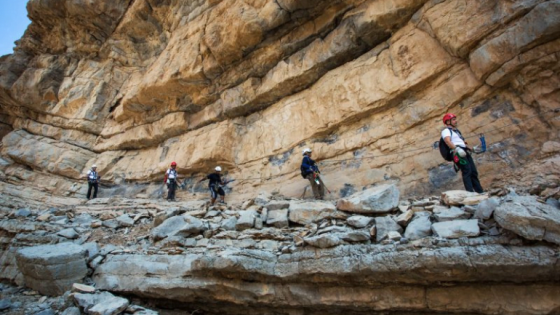Contents
UAE Karst topography forms from the dissolution of soluble carbonate rocks such as limestone, dolomite, and gypsum. It is distinguished by features such as poles above and drainage systems with sinkholes and caves beneath. Given the right conditions, it has also been observed in more weathering-resistant rocks, such as quartzite. Subterranean drainage may limit surface water, as in the United Arab Emirates, which has no rivers or lakes.
Distinctive karst terrain features may occur only at subsurface levels, in regions where the dissolved bedrock is covered (possibly by debris), or confined by one or more superimposed non-soluble rock strata.
UAE Karst topography
Karstological prospecting in Ras Al-Khaimah Emirate UAE revealed Several Musandam Mountains locations have been investigated for caves, karst springs, and surface karst features. Basic physical, chemical, and microbiological parameters were determined for two karst springs, Khatt and MeBreda.
Although they are both recharged by karst aquifers, they are not the same. The first is a thermal spring, which combines infiltrated rainwater with more saline and mineralized water from deeper levels. The second, at a high altitude of 710 m, is influenced by the presence of a less permeable zone within a carbonate aquifer with a higher proportion of dolomite.
Nitrate concentrations were higher, most likely due to grazing goats in the spring, but total bacterial counts were surprisingly low; however, detected Escherichia coli indicated possible fecal contamination. None of the tested sites’ water met the ISO criteria for direct human consumption.
Read more: UAE Cartography
UAE karst landscape
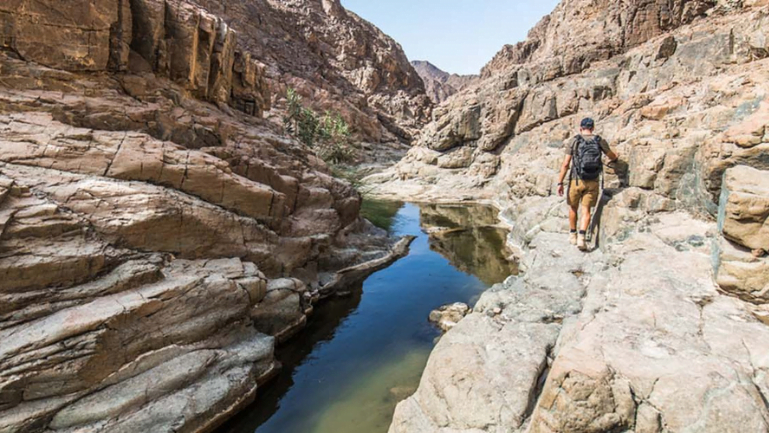
Surface rock relief caused by various karst processes was studied in river beds, wadi side walls, and mountain plateaus. Large recesses, relatively rare subsoil forms, and Karren with micro drills and rain lutes frequently dissect the wadi slopes. More extensive Karren can be found on mountain peaks. Rapid water currents and corrosion in contact with sediment shaped the rocky riverbeds of Wadis where karst landscapes and karst topography and a scenic.
There were no large caves discovered in the study area on the northern slopes of the mountains. The largest cave discovered was a tectonic fracture that was extended due to the gravitational sliding of a mountain along a fissure.
However, several small (10 – 20 m long) solutional caves have been discovered and surveyed on the Wadi’s slopes. They have a relatively simple arrangement of mostly dead-end passages. Caves are distributed vertically at various levels above the wadis.
Take a look at: UAE Coastal Climate
karst Springs & Caves & Rock features
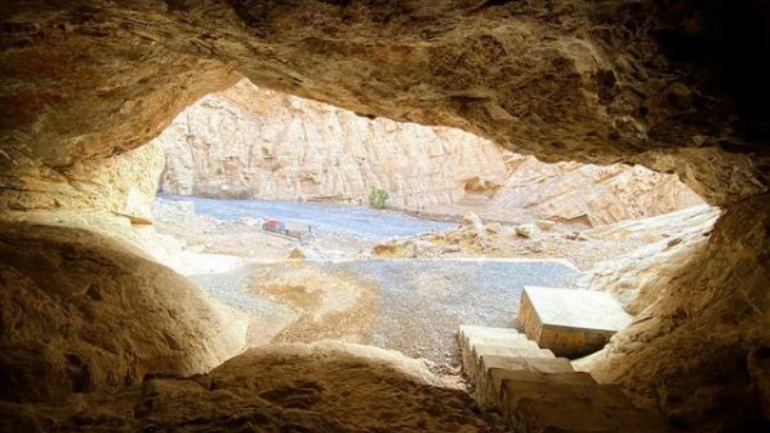
The rocky relief of the caves indicates the caves’ para-genetic development in tropical karst. Some of the caves studied were completely or partially filled with yellow clastic sediments. A few layers of low stone, calcite crystals, and gypsum crystals were also discovered. Mineralogical analyses reveal that sediments and minerals such as quartz, gypsum, kaolinite, smectite, illite, calcite, and palygorskite have very similar compositions. Calcite and gypsum are cave precipitates (crusts, crystals, and cement), while the other minerals were most likely brought to the cave by water or wind from eroded rocks and soils in Wadis catchment areas, karst springs, caves, and rock features.
Read more: UAE Coastal Geography
Karst in Ras Al-Khaimah, Northern United Arab Emirates
The Oman Mountains, which are dominated by a north-south alignment of mountain ridges, are the highest area in the UAE; the highest peaks of the mountains reach above 2,000 m. Our research site is in the UAE several locations in the Musandam Mountains of Ras Al-Khaimah, in the northern Emirates UAE.
The northern UAE’s current climate is highly arid, with summer temperatures reaching 50 °C and winter temperatures rarely falling below 14 °C. Rain falls irregularly and infrequently, mostly during the winter. The average annual rainfall is 135 mm on the west side of the mountains and 129 mm in Dibba (east side), but it can be higher at higher altitudes, as in Wadi Al-Bih, which has a rainfall of 166 mm.
In Wadi Al-Bih, the average annual surface run-off is 19 mm. In wadis like Wadi Al-Bih, flash floods occur once or twice a year. They may occur only once every ten years in other wadis. Several studies on caves and karst have been conducted in the Arabian Peninsula. Saudi Arabia has conducted the most extensive research.
Take alook at: UAE Annual Precipitation
UAE Karst Geological
On the map of UAE, Oman and the UAE are located on the Arabian plate’s northeastern margin. The active spreading axes of the Gulf of Aden and the Red Sea border this plate to the south and southwest. Transcurrent fault zones form its eastern and western borders. Along the Zagros and Makran fold and thrust belts, a complex continent-continent to continent-ocean collision boundary marks the plate’s northern edge.
Two distinct orogenic events separated by a period of tectonic quiescence formed the Northern Oman Mountains. These are the Late Cretaceous ophiolite abduction tectonics of the Oman Mountains and the Dibba zone, as well as the Cenozoic thrusting of the Zagros orogeny, which occurred primarily during the Oligocene-Miocene.
As a result, the current Northern Oman Mountains are made up of several major tectonostratigraphic units, including a pre-Permian Basement, the Hajar Unit, the Hawasina Nappes, the Samail Ophiolite, and metamorphic sole, as well as postnappe structural units.
The Musandam Mountains, which form the northeastern portion of the Oman Mountains, spread east of the Dibba fault zone. On the Arabian continental margin, the Musandam Carbonates were deposited in shallow water. The Samail Ophiolite is part of the Tethyan Ocean, a crust formed at a Middle Cretaceous spreading center (Cenomanian). The ocean closed during the late Cretaceous, and the Musandam Carbonates and Semail Ophiolites were tectonically shifted over the Hawasina Unit.
Read more: Humidity Levels in UAE
Present-day topography
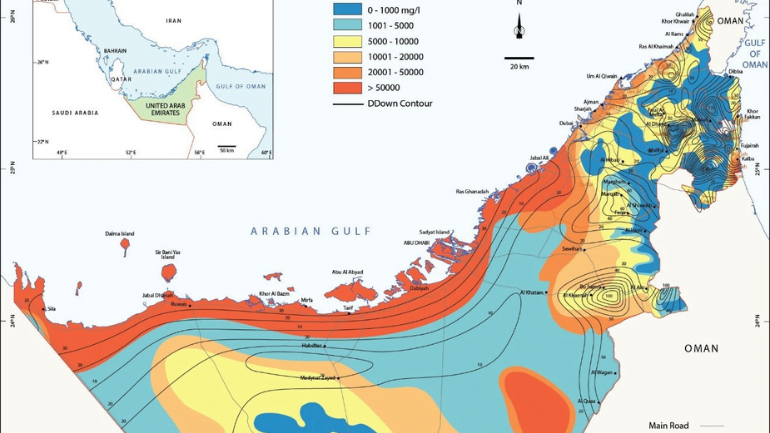
The current topography is thought to have formed during a later Cenozoic orogenic event. The drainage network in the northern UAE began with the emergence and uplift of the Musandam Peninsula in the Miocene. The UAE-Oman mountain range, on the other hand, has only been a barrier for the last eighteen to twenty million years, influencing the climatic conditions there.
Massive terraces of sediment sediments accumulated in wadis at the foot of the Musandam Mountains during the Pleistocene. Wadis of various sizes, ranging from small gorges to large valleys, cut through the limestone mountain ranges, creating a unique image of fluvial relatively densely dissected karst. On their slopes, unique caves with distinctive rock relief forms developed.
Carbonate rocks of the Musandam Group (Lower, Middle, and Upper Musandam limestone) of Upper Jurassic to Lower Cretaceous age, carbonates of the Russ Al Jibal Group (Bih dolomites, Haqil limestone, and Ghail limestones) of Middle Permian to Middle Triassic age, and mudstones of Upper Triassic to Lower Jurassic age dominated the studied areas.
Thirty-nine samples were collected from six study areas to create eighty-nine microscopic thin sections that were examined from petrological and lithostratigraphic perspectives, in order to investigate the causes of selective karstification as lithostratigraphic contacts of the rock and determine if any were significant. All samples were also calorimetric complexometrically analyzed.
Read more: Impact of Global Warming on UAE
Hydrogeological Properties & Water Quality
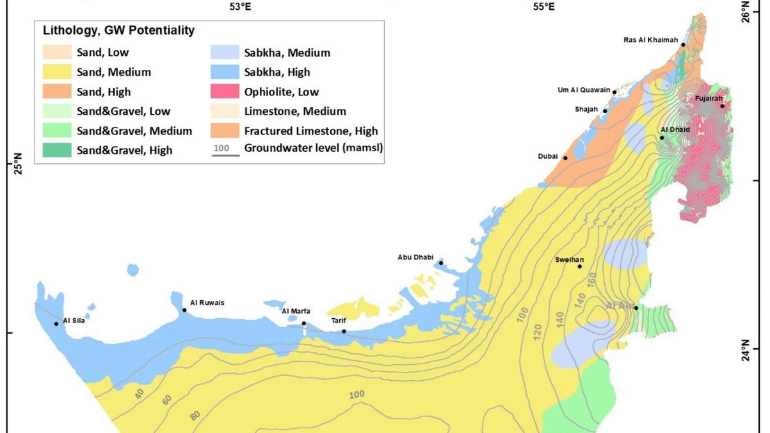
The UAE’s hydrogeological characteristics are heavily influenced by low precipitation and high potential evaporation. Almost all rainwater drains as surface runoff in the form of seasonal floods, and only 2 to 3% of it, according to some estimates, recharges groundwater.
Aquifers store groundwater in four types: karst in carbonate rocks, fissures in ophiolites, and intergranular in gravel and sand dunes. Wadis are characterized by karst aquifers on rocky slopes and intergranular aquifers of sediment and deposits. Surface water that drains through wadis is the primary source of recharge for intergranular aquifers in Quaternary alluvial deposits composed of gravel and sand with thin interbeds of silt and clay.
Limestone and dolomite make up karst aquifers. Rain infiltration recharges them, and karst springs in contact with less permeable rocks and discharges them into the sea. Khatt and MeBreda karst springs have very different hydrogeological characteristics. In addition, for comparison, the basic physical and bacteriological parameters of samples taken at the pumping station in an intergranular aquifer and in a small collector of surface water on a rocky slope of the Wadi Haqil were defined.
Read more: Cultural Awareness in UAE
What types of rocks are found in the UAE?
The caves’ rocky relief indicates their para-genetic development. Yellow clastic sediments completely or partially filled some of the caves studied. There were also a few layers of low stone, calcite crystals, and gypsum crystals discovered.
What is the topography of the UAE?
The United Arab Emirates is primarily an arid land with vast sand deserts, but it also has sand dunes, oases, rock mountains, valleys, marshes and mangroves, and salt plains. The oases are mostly made up of date palms, and the majority of them are in the emirate of Abu Dhabi.
What is the geological formation of the karst topography in the UAE?
The UAE’s geology includes very thick Paleozoic, Mesozoic, and Cenozoic marine and continental sedimentary rocks overlying deeply buried Precambrian rocks. The region has abundant oil and gas resources and has been deformed by more distant tectonic events over the last several million years.
What is the geographical environment of the UAE?
The UAE has an arid desert climate with only two seasons, winter and summer, which are separated by two transitional periods. The average temperature in winter (December to March) ranges from 16.4 °C to 24 °C.
The UAE Karst topography and caves are underexplored. The Emirates Natural History Group has primarily conducted research in Jebel Hafit and the northern slopes of the Musandam Mountains by karst geomorphology, the science of landforms. According to existing literature, little research has been done on caves or karst in the northern UAE. One of the objectives was to look for karst areas or locations that could be used for tourism. The exploration and study areas were on Mount Al Jeer’s northern slopes, in Wadi Haqil, in Wadi Bih and its tributaries Wadi Shehah (Me-Breda) and (valley) Wadi Shie Hat, and in Wadi Taweeyan, a tributary of Wadi Maai.
